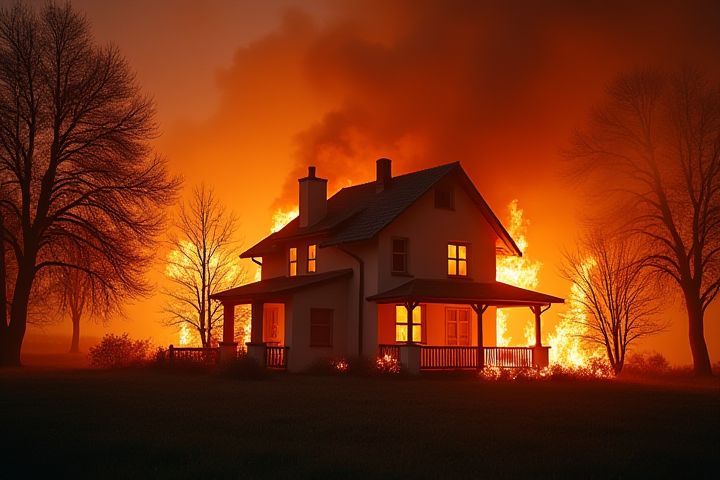
House fires commonly start due to cooking accidents, electrical malfunctions, and the improper use of heating devices. Cooking accounts for nearly half of residential fires, often arising from unattended stoves or flammable materials nearby. Electrical issues, such as faulty wiring, overloaded circuits, or malfunctioning appliances, can ignite fires if not promptly addressed. Improperly maintained heating equipment, including space heaters and fireplaces, poses significant risks, particularly during colder months. To protect your home, ensure that smoke detectors are installed and functioning, and that fire extinguishers are readily accessible in case of emergencies.
Why House Fires Start
Cooking incidents
Cooking incidents are the leading cause of house fires, accounting for nearly half of all residential fire outbreaks. Grease fires, often ignited by unattended frying pans or cooking oil, can spread rapidly, posing significant risks to your home and safety. Common kitchen appliances, like stoves and toasters, can malfunction or be misused, increasing the likelihood of an accident. To mitigate these risks, always stay present when cooking, keep flammable items away from heat sources, and maintain a clean cooking environment free from grease accumulation.
Heating equipment malfunction
Heating equipment malfunction is a significant cause of house fires, responsible for approximately 39% of residential fire incidents. Common culprits include malfunctioning furnaces, space heaters, and chimneys, which can ignite nearby combustible materials. Regular maintenance, such as cleaning flues and inspecting heaters, can greatly reduce the risk of fires associated with these heating devices. Ensuring your heating equipment is up to code and functioning properly is essential for protecting your home and loved ones from potential fire hazards.
Electrical wiring issues
Electrical wiring issues are a leading cause of house fires, often stemming from outdated systems or improper installations. Faulty connections, degraded insulation, and overloaded circuits can generate excessive heat, igniting nearby flammable materials. Regular inspections and updates to your electrical system can help mitigate risks associated with aging wiring and ensure compliance with current safety standards. Using high-quality materials and hiring certified electricians for installations significantly reduces the likelihood of fire hazards in your home.
Smoking-related accidents
Smoking-related accidents are a significant cause of house fires, leading to thousands of incidents annually. In 2020, the National Fire Protection Association reported that nearly 18,000 fires were attributed to smoking materials, resulting in over $500 million in property damage. Neglected cigarettes, improperly extinguished ashes, and lit smoking materials placed near flammable items significantly increase the risk of ignition. Ensuring safe disposal of smoking materials and maintaining smoke-free environments can greatly reduce these hazards in your home.
Flammable liquids mishandling
Flammable liquids, such as gasoline, paint thinners, and solvents, are significant contributors to house fires when mishandled. Improper storage in unsealed containers or near heat sources can lead to vapor accumulation and ignition. Pouring or transferring these liquids carelessly increases the risk of spills, creating hazardous conditions that can ignite from sparks or open flames. Maintaining proper safety practices, including using suitable containers and keeping these substances away from heat and flames, is essential for preventing devastating fires in your home.
Candle usage
Candle usage is a leading cause of house fires, accounting for approximately 8% of all residential blazes reported annually. More than 20% of candle-related incidents occur because candles are left unattended, highlighting the importance of supervision and safety measures. It is essential to place candles on stable surfaces, ideally at least 12 inches away from flammable materials such as curtains and paper. In your home, consider using flameless LED candles as a safer alternative to reduce the risk of fire-related accidents.
Appliance overheating
Appliance overheating is a leading cause of house fires, contributing to approximately 27% of all residential fire incidents. Common culprits include dryers, stoves, and space heaters, often resulting from neglected maintenance or improper use. For example, failing to clean lint traps in dryers can cause temperatures to rise excessively, igniting surrounding materials. Maintaining appliances by regularly inspecting cords and ensuring ventilation can significantly reduce your risk of a devastating fire.
Faulty lighting
Faulty lighting is a leading cause of house fires, accounting for approximately 13% of residential fire incidents. Overloaded circuits, frayed wires, and outdated fixtures can lead to overheating and spark ignition. For instance, using a light bulb with a higher wattage than recommended can cause overheating in light fixtures, increasing the risk of fire. Regular inspections and maintenance of your home's electrical system can significantly reduce the danger associated with faulty lighting.
Dryer lint buildup
Dryer lint buildup is a significant fire hazard commonly overlooked in household safety. Over time, lint accumulates in dryer vents and filters, restricting airflow and causing the dryer to overheat. It's essential to clean the lint trap after every use and periodically inspect and clean the venting system to prevent dangerous obstructions. By maintaining your dryer properly, you reduce the risk of fire and ensure the appliance operates efficiently and safely.
Arson activities
Arson activities account for approximately 20% of all reported house fires in the United States, significantly impacting public safety and property loss. Typically motivated by revenge, financial gain, or mental health issues, arsonists use various incendiary methods to ignite flames. The average cost of damages caused by a single arson fire can exceed $17,000, placing financial strain on affected families and communities. Understanding the motivations behind arson can help in developing preventative measures to protect your home and neighborhood.
